Spinal Nerves
They are those that connect with the spinal cord and are responsible for innervating the trunk, upper limbs and parts of the head. There are a total of 31 pairs, 33 if the two pairs of vestigial coccygeal nerves are counted, which correspond to the 31 existing medullary segments.
Are:
- 8 pairs of Cervical Nerves
- 12 pairs of Thoracic Nerves
- 5 pairs of Lumbar Nerves
- 5 pairs of sacral nerves
- 1 pair of coccygeal nerves
| NERVE ROOTS RELATIONSHIP WITH THE VERTEBRAE |
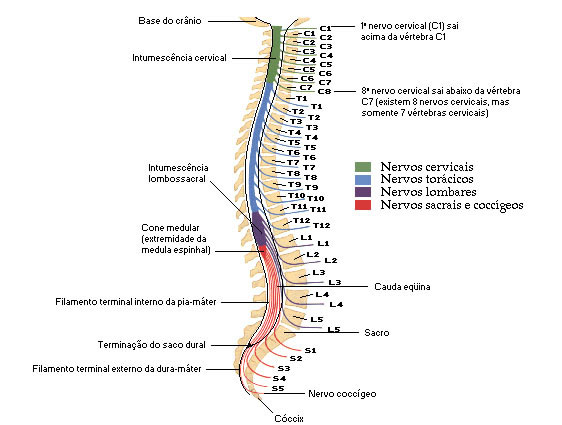 |
| Source: NETTER, Frank H.. Atlas of Human Anatomy. 2nd edition Porto Alegre: Artmed, 2000. |
Each spinal nerve is formed by the union of the dorsal (sensory) and ventral (motor) roots, which connect, respectively, to the posterior lateral and anterior lateral grooves of the cord through root filaments.
The Ventral Root emerges from the ventral surface of the spinal cord as several rootlets or filaments that usually combine to form two bundles near the intervertebral foramen.
The Dorsal Root is larger than the ventral root in size and number of rootlets; these attach along the posterior lateral sulcus of the spinal cord and unite to form two bundles that penetrate the spinal ganglion.
The ventral and dorsal roots unite just beyond the spinal ganglion to form the spinal nerve, which then emerges through the interspinal foramen.
The spinal ganglion is a cluster of nerve cells in the dorsal root of the spinal nerve. It has an oval shape and size proportional to the dorsal root in which it is located. It is close to the intervertebral foramen.
| SPINAL NERVE FORMATION - VENTRAL AND DORSAL ROOTS |
 |
| Source: NETTER, Frank H.. Atlas of Human Anatomy. 2nd edition Porto Alegre: Artmed, 2000. |
The spinal nerve separates into two primary divisions, dorsal and ventral, immediately after the junction of the two roots.
Dorsal Branches of Spinal Nerves
The dorsal branches of the spinal nerves, generally smaller than the ventral and directed posteriorly, divide (except for the first cervical, fourth, and fifth sacral and coccygeal nerves) into medial and lateral branches to innervate the muscles and skin of the posterior regions of the spinal cord. neck and trunk.
Dorsal Branches of Cervical Spinal Nerves
The first dorsal cervical branch called the suboccipital nerve emerges superior to the posterior arch of the atlas and inferior to the vertebral artery. It penetrates the suboccipital trigone innervating the greater and lesser posterior rectus capitis, superior and inferior obliques, and semispinatus capitis.
The second dorsal cervical branch and all other dorsal cervical branches emerge between the posterior arch of the atlas and the lamina of the axis, below the inferior oblique muscle innervated by it, receiving a connection from the dorsal branch of the first cervical, and divides into a large medial branch and a small lateral branch. The medial branch is called the greater occipital nerve, which together with the lesser occipital nerve innervates the skin from the scalp to the apex of the skull. It innervates the semispinatus muscle of the head. The lateral branch supplies the splenius, capitis longissimus, and capitis semispinatus muscles.
The third cervical dorsal branch divides into medial and lateral branches. Its medial branch runs between the spinal muscles of the head and semispinal muscles of the neck, piercing the splenius muscle and trapezius muscle to end in the skin. Deep to the trapezius muscle, it gives rise to a branch, the third occipital nerve, which pierces the trapezius muscle to terminate in the skin of the lower part of the occipital region, medial to the greater occipital nerve. The lateral branch frequently joins that of the second dorsal cervical branch.
The dorsal branches of the five inferior cervical nerves divide into medial and lateral branches. The medial branches of the fourth and fifth run between the semispinatus of the neck and semispinatus of the head, reach the spinous processes of the vertebrae, and pierce the splenius muscle and the trapezius muscle to terminate in the skin. The medial branch of the fifth may not reach the skin. The medial branches of the three inferior cervical nerves are small and terminate in the semispinal neck, semispinal capitis, multifidus, and interspinal muscles. The lateral branches supply the iliocostalis muscles of the neck, longissimus neck and longissimus head.
| DORSAL BRANCHES OF THE CERVICAL SPINAL NERVES |
 |
| Source: NETTER, Frank H.. Atlas of Human Anatomy. 2nd edition Porto Alegre: Artmed, 2000. |
| |
| DORSAL BRANCHES OF THE CERVICAL SPINAL NERVES |
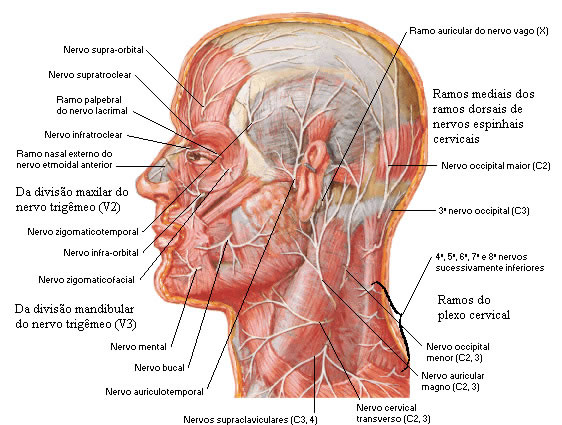 |
| Source: NETTER, Frank H.. Atlas of Human Anatomy. 2nd edition Porto Alegre: Artmed, 2000. |
Dorsal Branches of Thoracic Spinal Nerves
They divide into medial and lateral branches. Each medial branch runs between the joint and the medial margins of the superior costotransverse ligament and the intertransverse muscle, while each lateral branch runs in the interval between the ligament and the intertransverse muscle before sloping posteriorly over the medial side of the levator ani muscle. rib.
| DORSAL BRANCHES OF THE THORACIC SPINAL NERVES |
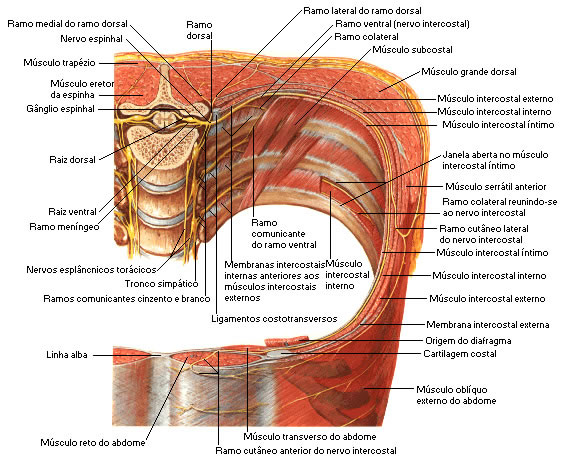 |
| Source: NETTER, Frank H.. Atlas of Human Anatomy. 2nd edition Porto Alegre: Artmed, 2000. |
| DORSAL BRANCHES OF THE THORACIC SPINAL NERVES |
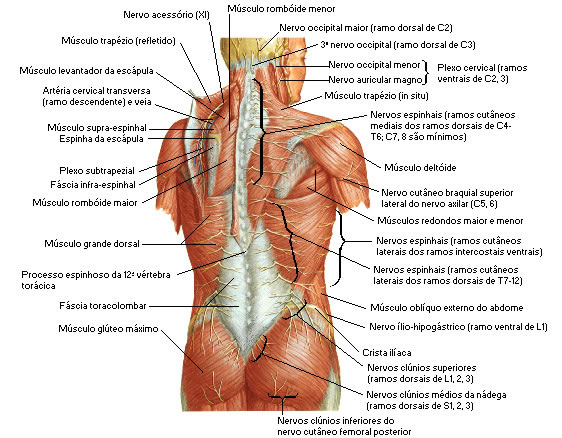 |
| Source: NETTER, Frank H.. Atlas of Human Anatomy. 2nd edition Porto Alegre: Artmed, 2000. |
Dorsal Branches of Lumbar Spinal Nerves
The dorsal branches of the lumbar nerves pass backwards medial to the intertransverse muscles, dividing into medial and lateral branches. The medial branches run close to the articular processes of the vertebrae to terminate in the multifidus muscle; they are related to the bone between the accessory and mammillary processes and can furrow it. In addition, the upper three give rise to the cutaneous nerves that perforate the aponeurosis of the latissimus dorsi muscle on the lateral border of the erector spinae muscle and cross the iliac muscle, posteriorly, to reach the skin of the gluteal region.
| DORSAL BRANCH OF A LUMBAR SPINAL NERVE |
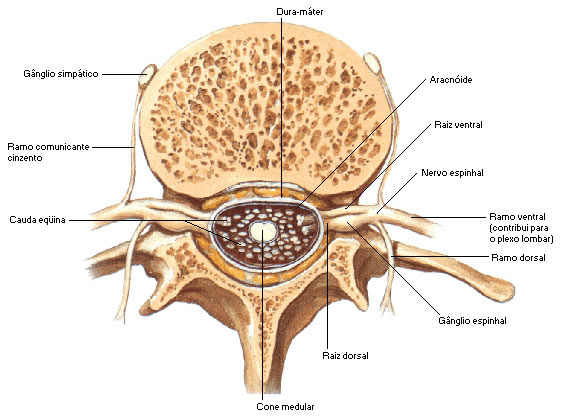 |
| Source: NETTER, Frank H.. Atlas of Human Anatomy. 2nd edition Porto Alegre: Artmed, 2000. |
Dorsal Branches of Sacral Spinal Nerves
The upper three are covered at the exit by the multifidus muscle, dividing into medial and lateral branches. The medial branches are small and terminate in the multifidus muscle. The lateral branches unite and with the lateral branches of the last lumbar and dorsal branches of the fourth sacral nerve, they form dorsal loops to the sacrum; from these loops, branches run dorsally to the sacrotuberous ligament to form a second series of loops under the gluteus maximus muscle; of these, two or three gluteal branches pierce the gluteus maximus muscle to innervate the skin of the gluteal region.
Ventral Branches of Spinal Nerves
The ventral branches of the spinal nerves innervate the limbs and the anterolateral aspects of the trunk. The cervical, lumbar, and sacral unite near their origins to form plexuses.
